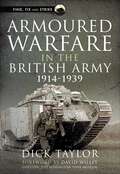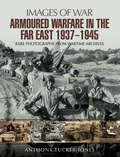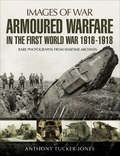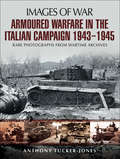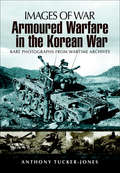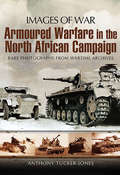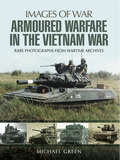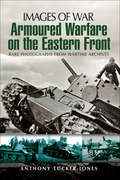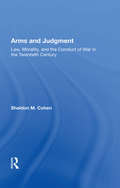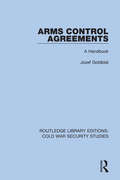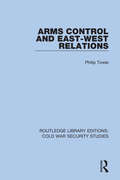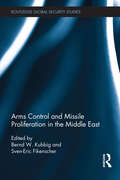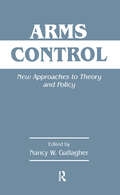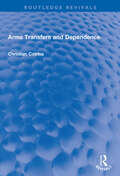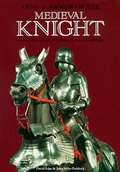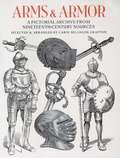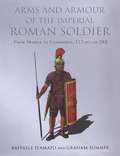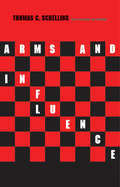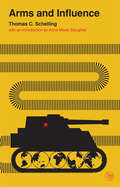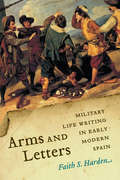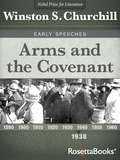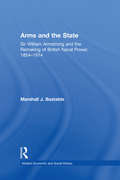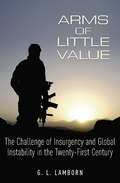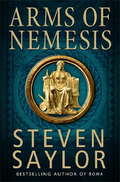- Table View
- List View
Armoured Warfare in the British Army, 1914–1939 (Find, Fix and Strike)
by Richard TaylorThis is the first volume in a three-volume illustrated history of the evolution of armored manoeuvre warfare in the British army, covering the period from 1914 until 1939. Author Dick Taylor’s tour de force covers the evolution of the tank and armored cars in response to the specific conditions created by trench warfare, the history of the use of tanks during the war, as well as the critical period between the wars in which the tank was both refined and neglected. He also looks in detail at the amalgamations and mechanization of the horsed cavalry which led to the formation of the Royal armored Corps in 1939. His detailed and absorbing narrative covers the social and human aspects of the story as well as the technology, and explains how the nation that invented and first fielded the tank in 1916 struggled to maintain the lead after the Armistice.
Armoured Warfare in the Far East, 1937–1945: Rare Photographs From Wartime Archives (Images of War)
by Anthony Tucker-JonesAnthony Tucker-Jones's photographic history is a fascinating visual introduction to the armoured battles of the Second World War in the Far East and Asia-Pacific regions, from 1937 to 1945. In contrast to the experience of the armies that fought in Europe and North Africa, in the Far East tanks remained an infantry support weapon, and their role is often neglected in histories of the conflict. Japanese armour confronted tanks deployed by the Chinese, Russians, British and Americans. Early in the war, against Chinese forces which lacked armour, the Japanese had some success, but their light and medium tanks were no match for their Allied counterparts. Later Japanese designs were better armed, but they were built in such small numbers that they could do little to stem the Allied advance. The role of armoured vehicles in each theatre of the war in the Far East is shown in a selection of over 150 rare wartime photographs that record armour in action in China, Manchuria, Mongolia, Malaya, Burma and during the battles fought for the Pacific islands.
Armoured Warfare in the First World War 1916-18: Rare Photographs From Wartime Archives (Images of War)
by Anthony Tucker-JonesA hundred years ago, on 15 September 1916, on the Western Front during the Battle of the Somme, the tank made its debut on the battlefield. The first tanks were crude, unreliable, vulnerable weapons, but they changed the character of land warfare forever, and Anthony Tucker-Jones's photographic history of these pioneering armored vehicles is the ideal introduction to them. In a selection of over 150 archive photographs he offers a fascinating insight into the difficult early days of this innovative new weapon, describing its technical history and its performance in combat. While the Battle of Cambrai in 1917 is often held up as the first large-scale tank battle, tanks had already served at Flers-Courcelette on the Somme, during the Nivelle offensive and the battles of Messines and Passchendaele. His book shows that the development of the tank was fraught with technical obstacles and battlefield setbacks. It was invented by the British and the French at almost the same time to help break the deadlock of trench warfare, and the British deployed it first in 1916. Belatedly the Germans followed the British and French example. The initial designs were continuously refined during two years of intense warfare. Finding the right balance between power and weight, getting the armament right, and working out the best tactics for tanks on the battlefield was a tricky, often deadly business.
Armoured Warfare in the Italian Campaign, 1943–1945: Rare Photographs from Wartime Archives (Images of War)
by Anthony Tucker-JonesThis WWII pictorial history illustrates the wide array of armored vehicles deployed by Allied and Axis powers in Italy.The Second World War campaigns in North Africa, on the Eastern Front and in northwest Europe were dominated by armored warfare, but the battles in Italy were not. The Italian peninsula&’s mountainous terrain was best suited to an infantry war. Yet from the Allied landings in Sicily in 1943 to the German surrender after the crossing of the Po in 1945, tanks, self-propelled guns and armored cars were essential elements in the operations of both sides. Anthony Tucker-Jones&’s selection of rare wartime photographs shows armor in battle at Salerno, Anzio and Monte Cassino, during the struggle for the Gustav Line, the advance on Rome and the liberation of northern Italy. These dramatic images reveal the full array of Axis and Allied armored vehicles that was deployed, including German Panzers, Panthers, and Tigers and Allied Stuarts, Chafees, Shermans and Churchills. They also vividly illustrate the Italian landscapes over which the campaign was fought and the grueling conditions endured by the men who fought in it.
Armoured Warfare in the Korean War: Rare Photographs from Wartime Archives (Images of War)
by Anthony Tucker-JonesAfter the Second World War, military analysts thought that the only place significant armored forces were ever likely to confront each other again was in central Europe where the Nato alliance would fend off the Soviet Red Army. Then during the Korean War of 1950-53 both sides deployed large numbers of armored fighting vehicles, and this neglected aspect of the conflict is the subject of Anthony Tucker-Joness photographic history. Korea, with its rugged mountains, narrow passes, steep valleys and waterlogged fields was not ideal tank country so the armor mainly supported the infantry and rarely engaged in battles of maneuver. Yet the wide variety of armor supporting UN and North Korean forces played a vital if unorthodox role in the swiftly moving campaigns. For this fascinating book over 180 contemporary photographs have been selected to show Soviet-built T-34/85s and Su-76s, American M4 Shermans, M26 Pershings and M46 Pattons, and British Cromwells and Centurions in action in one of the defining conflicts of the Cold War.
Armoured Warfare in the North African Campaign: Rare Photographs from Wartime Archives (Images of War)
by Anthony Tucker-JonesThe North African campaign, the struggle of the Italians and Germans against the Allies in Egypt, Libya and Tunisia between 1940 and 1943, was a war of movement and maneuver, of dramatic changes of fortune, and it was a war in which mechanized forces—tanks in particular—excelled. Compared with the heavily populated landscapes of northwest Europe, the empty open spaces of North Africa appeared to be ideal operating terrain for tanks, yet the harsh desert conditions tested men and machinery to the limit, as Anthony Tucker-Jones demonstrates in this remarkable selection of wartime photographs.The use of armor during the entire course of the campaign is covered, from the initial Italian offensive, the arrival of Rommels Panzergruppe Afrika, the battles fought along the North African shore which culminated in El Alamein, then the Allied advance into Tunisia which led to the final defeat of the German and Italian armies.The images give a fascinating inside view of combat, but they also reveal the daily routines of tank warfare 65 years ago, and give a vivid impression of what it was like to fight in and live with the tanks of the day the German Mk IIIs and Mk IVs and the Tiger, the British Matildas and Valentines and the American Grants and Shermans that contributed so much to the Allied victory. Training, maintenance, transportation and supply are shown, as are the daily lives of the tank crews and extreme conditions in which they worked and fought.
Armoured Warfare in the Vietnam War: Rare Photographs From Wartime Archives (Images of War)
by Michael GreenThis pictorial history of the Indochina and Vietnam Wars captures the range of armored warfare used in the region through rare wartime photographs. The two conflicts that engulfed Indochina and Vietnam in the decades after World War II are generally thought of as infantry wars. But in fact, they both involved a significant amount of armored warfare. In this fully illustrated volume, military expert and Vietnam veteran Michael Green describes the many kinds of armored vehicles deployed and their contributions in combat. The ill-fated French Expeditionary Force of the Indochina War was largely equipped with World War II era American tanks—including M3 and M5 Stuart, M4 Sherman and M24 light tanks—as well as armored cars and half-tracks. Most of these eventually went to the Army of the Republic of Vietnam, but were outdated and ineffective due to lack of logistics and training. The US Army and Marine Corps build-up in the 1960s saw vast quantities of M48 Pattons, M113 APCs and many specialist variants and improvised armored vehicles arrive in the theatre. The Australians also brought their British Centurion tanks. But it was the Russians, Chinese and North Vietnamese who won the day and their T-38-85 tanks, ZSU anti-aircraft platforms.
Armoured Warfare on the Eastern Front: Rare Photographs from Wartime Archives (Images of War)
by Anthony Tucker-JonesA pictorial history and analysis of the tank warfare between Red Soviet and Nazi forces along the Eastern Front during World War II. On the Eastern Front during the Second World War, massive Soviet and German tank armies clashed in a series of battles that were unmatched in their scale and ferocity. Several of them have attained almost legendary status. But epic encounters such as these were only part of a broader story, as Anthony Tucker-Jones demonstrates in this selection of graphic photographs. While the images give a fascinating inside view of combat, they also reveal the daily routines of tank warfare 65 years ago. Training, maintenance, transportation, and supply are shown, as are the daily lives of the tank crews and the often appalling conditions in which they worked and fought. The photographs also record in vivid detail the destructive reality of armored warfare, from the initial triumphant advance of the German panzers deep into the Soviet Union to the massive Red Army counter-offensives which drove the German armies back to Berlin.Praise for Armoured Warfare on the Eastern Front&“Each chapter includes a useful introduction and the pictures each come with an accurate and informative caption, describing the item in the picture and placing it in context, comparing it to its opponents at the time or looking at production numbers. This is a high quality piece of work, and a useful photographic guide to the armoured vehicles of the Eastern Front.&” —History of War
Arms And Judgment: Law, Morality, And The Conduct Of War In The 20th Century
by Sheldon M. CohenThis book examines the justifications of the use of armed force and their limits, as well as the law of war. It is a moral enquiry and adopts an interdisciplinary approach. The divergence between legality and morality, and its significance, is one of the underlying themes of the book.
Arms Control Agreements: A Handbook (Routledge Library Editions: Cold War Security Studies #5)
by Jozef GoldblatThis book, first published in 1982, provides a well-informed historical overview, insightful analysis and searching critique of arms control agreements and negotiations from the Hague Declaration of 1899 to the SALT Treaties and Conventions of the 1970s and 1980s. Arms control agreements of international importance and historical merit are assessed, for the extent to which each affected the arms race or reduced the likelihood of war.
Arms Control and East-West Relations (Routledge Library Editions: Cold War Security Studies #4)
by Philip TowleThis book, first published in 1983, examines the role that arms control has to play, alongside defence and deterrence, in stabilising East-West relations and reducing tensions during the Cold War. Arms control agreements were designed in the attempt to achieve parity between the nuclear forces of the superpowers, without making war more likely. A danger of confrontation between the USSR and the USA came from their involvement in Third World conflicts, and this arena is also discussed. The diplomatic approaches of the Soviet Union, the Third World and the West, and their aims in arms control, are also analysed.
Arms Control and Missile Proliferation in the Middle East (Routledge Global Security Studies)
by Bernd W. Kubbig Sven-Eric FikenscherThis edited volume provides a systematic analysis of the missile threat and proliferation issue in the Middle East region. The question of how to increase the level of security in the Middle East is not a new one, given the conflict-ridden nature of the region. The solution attempted for this predicament has typically revolved around intense arms build-ups, a strategy which can prove self-defeating due to the subsequent countermeasures employed by neighbouring states. Arms Control and Missile Proliferation in the Middle East focuses on the strategic proliferation of arms, with a specific emphasis on missiles. This unique emphasis enables the contributors to provide a dynamic new perspective on conceptual and political disarmament efforts, thereby distinguishing this volume from many other related works on the region, which deal mainly with weapons of mass destruction. The book also explores the possibility of a reduction in weapon arsenals, examining a more promising cooperative security concept which includes confidence- and security-building measures (CSBMs). This book will be of much interest to students of arms control, Middle Eastern politics, Gulf Security, war and conflict studies, security studies and IR.
Arms Control: New Approaches to Theory and Policy
by Nancy W. GallagherContents: Bridging the Gaps on Arms Control Nancy W. Gallagher. Arms Control in the Information Age Emily O. Goldman. A New Role for Transparency Ann M. Florini. Beyond Deterrence, Defence, and Arms Control Gloria Duffy. Nuclear Arms Control through Multilateral Negotiations Rebecca Johnson. The Impact of Govermental Context on Negotiation and Implementation: Constraints and Opportunities for Change Amy Sands. The Politics of Verification: Why How Much?' is Not Enough Nancy W. Gallagher.
Arms Transfers and Dependence (Routledge Revivals)
by Christian CatrinaFirst published in 1988, Arms Transfers and Dependence was written to provide a view of arms transfers in the context of the global distribution of power. The book analyses different types of dependence and is focused on comparing the enhancement of military capabilities as a result of arms transfers with the dependence that may be caused by those transfers. In doing so, it provides an overview of how particular structures of imports and exports of arms lead to dependence.
Arms and Armor of the Medieval Knight
by John Miles David EdgeTraces changes in armor and weaponry as the knight's rol in warfare and peacetime society changes from the Middle Ages through the 15th century. Book includes detailed descriptions and pictures of armor and weaponry worn during this long time span. The author explains how armor and weapons are influenced and changed.
Arms and Armor: A Pictorial Archive from Nineteenth-Century Sources (Dover Pictorial Archive)
by Carol Belanger GraftonOver thousands of years, man has developed an enormous variety of offensive and defensive weapons for use in battle as well as a vast array of armor and other protective devices. Now artists and illustrators can draw on this extensive archive for superb copyright-free illustrations of vintage arms, armor, and other battlefield paraphernalia. Choose from a rich trove of over 750 illustrations compiled from rare nineteenth-century sources. Included are detailed, high-quality depictions — arranged chronologically and, to some extent, geographically — of suits of armor, chain mail, swords, halberds, spears, pikes, lances, crossbows, axes, daggers, helmets, shields, knives, small arms, and a host of other implements, along with scenes of battle, siege, jousts, soldiers, horses, and more. Especially suitable for projects requiring a medieval or old-fashioned flavor, these illustrations reproduce extremely well. They will fill a myriad of needs for battle-related graphic art.
Arms and Armour of the Imperial Roman Soldier: From Marius to Commodus, 112 BC–AD 192
by Raffaele D'Amato Graham SumnerA survey of the various forms of armour worn by the Roman soldier from 112 BC to 192 AD, featuring a wealth of illustrations and plates. From the Latin warriors on the Palatine Hill in the age of Romulus, to the last defenders of Constantinople in 1453 AD, the weaponry of the Roman Army was constantly evolving. Through glory and defeat, the Roman warrior adapted to the changing face of warfare. Due to the immense size of the Roman Empire, which reached from the British Isles to the Arabian Gulf, the equipment of the Roman soldier varied greatly from region to region. Through the use of materials such as leather, linen and felt, the army was able to adjust its equipment to these varied climates. Arms and Armour of the Imperial Roman Soldier sheds new light on the many different types of armour used by the Roman soldier, and combines written and artistic sources with the analysis of old and new archaeological finds. With a huge wealth of plates and illustrations, which include ancient paintings, mosaics, sculptures and coin depictions, this book gives the reader an unparalleled visual record of this fascinating period of military history. This book, the first of three volumes, examines the period from Marius to Commodus. Volume II will cover the period from Commodus to Justinian, and Volume III will look at the period from Romulus to Marius. &“An impressive achievement, a testament to an enormous scholarly effort—and it is a significant contribution to the understanding of the Roman army.&” —Bryn Mawr Classical Review &“Without doubt, this is the definitive study of clothing, armour and weaponry worn by Roman soldiers during the golden age of their conquests...D&’Amato has brought together a remarkable collection of archaeological photographs gathered over decades to illustrate every aspect of this military evolution . . . A treasure trove of facts and illustrations that is essential reading for any Roman military enthusiast.&” —Tim Newark, Military Illustrated Magazine
Arms and Equipment of the Civil War (Civil War)
by Jack CogginsThe first military conflict to use iron-clad gunboats, metallic cartridges, and submarines, the Civil War also introduced such inventions as the telegraph and military balloon, utilized by the Signal Corps. This comprehensive reference brings a fresh perspective to wartime victories and defeats, with vivid descriptions of how the war was fought and what materiel was available to armies and navies of the Union and the Confederacy. Profusely illustrated with hundreds of the author's own drawings, Jack Coggins's remarkable encyclopedia of military hardware and technology also describes such equipment as pontoon bridges, corduroy roads, "excelsior" percussion grenades, "freak guns," siege artillery, mines, and submarine torpedoes. Offering a new view on how military resources decided the outcome not only of battles, but of the war as well, the text also includes on-the-scene comments by Union and Confederate soldiers about equipment and camp life in general. A must-have book for every Civil War enthusiast and for readers interested in the development of weaponry.
Arms and Influence
by Prof. Thomas C. SchellingThe author concentrates in this book n the way in which military capabilities real or imagined are used, skillfully of clumsily, as bargaining power. He sees the steps taken by the U. S. during the Berlin and Cuban crises as not merely preparations for engagement, but as signals to and enemy, with reports from the adversary's own military intelligence as our most important diplomatic communications.
Arms and Influence (Veritas Paperbacks)
by Thomas C. Schelling&“This is a brilliant and hardheaded book. It will frighten those who prefer not to dwell on the unthinkable and infuriate those who have taken refuge in stereotypes and moral attitudinizing.&”—Gordon A. Craig, New York Times Book Review Originally published more than fifty years ago, this landmark book explores the ways in which military capabilities—real or imagined—are used, skillfully or clumsily, as bargaining power. Anne-Marie Slaughter&’s new introduction to the work shows how Schelling&’s framework—conceived of in a time of superpowers and mutually assured destruction—still applies to our multipolar world, where wars are fought as much online as on the ground.
Arms and Letters: Military Life Writing in Early Modern Spain (Toronto Iberic)
by Faith S. HardenArms and Letters analyses the unprecedented number of autobiographical accounts written by Spanish soldiers during the sixteenth and seventeenth centuries. These first-person retrospective works recount a range of experiences throughout the sprawling domain of the Hispanic monarchy. Reading a selection of autobiographies in contemporary historical context – including the coalescing of the first modern armies, which were partially populated by forced recruits and the urban poor – Faith S. Harden explains how soldiers adapted the concept of honour and contributed to the burgeoning autobiographical form. Harden argues that Spanish military life writing took two broad forms: the first as a petition, wherein the soldier’s service was presented as a debt of honour, and second, as a series of misadventures, staging honour as a spectacle that captivated an audience. Honour was inevitably gendered and performative, and as such, it functioned as one of the overarching metrics of value that early modern men and women applied to themselves and others. In charting how non-elite subjects rendered their lives legitimate through autobiography, Arms and Letters contributes both to a critical genealogy of honour and to the history of life writing.
Arms and the Covenant (Winston S. Churchill Early Speeches)
by Winston S. ChurchillThis inspiring collection of campaign speeches from the British prime minister bring his oratory brilliance and powers of persuasion to life. Legendary politician and military strategist Sir Winston Churchill was a master not only of the battlefield, but of the page and the podium. Over the course of forty books and countless speeches, broadcasts, news items and more, he addressed a country at war and at peace, thrilling with victory but uneasy with its shifting role on the global stage. In 1953, he was awarded the Nobel Prize for Literature for &“his mastery of historical and biographical description as well as for brilliant oratory in defending exalted human values.&” During his lifetime, he enthralled readers and brought crowds roaring to their feet; in the years since his death, his masterful writing has inspired generations of eager history buffs. Well before Britain entered World War II, Winston Churchill warned his government about the growing Nazi threat, even as many European leaders were still urging caution and diplomacy. In this collection of forty-one speeches from 1928 to 1938, the great politician&’s prescience and political skill—vital to Britain&’s role as the first country to stand against Hitler—are clearly on display. This collection, which includes the famous &“Disarmament Fable&” speech, presents a fascinating look at Churchill&’s campaign to mobilize Britian against the rising Nazi threat, and showcases his versatility and genius as one of the best orators of the twentieth century.
Arms and the State: Sir William Armstrong and the Remaking of British Naval Power, 1854–1914 (Modern Economic and Social History)
by Marshall J. BastableArms and the State is a history of Britain's first and foremost modern armaments company, the Armstrong Whitworth Company, from its origins in 1854 to 1914. It focuses on the role of Sir William G. Armstrong, an engineer and entrepreneur who transformed his modest mechanical engineering business into a vast industrial enterprise which invented, developed, manufactured and sold heavy guns and warships throughout the world. Arms and the State reconstructs the global arms trade as it follows Armstrong's companies selling the latest weapons to both sides in the American Civil War, Egypt, Turkey and Italy in the 1860s, to China, Chile and Japan in the 1870s and 1880s, and became Britain's leading armaments company in the age of the naval arms races that preceded the First World War. In so doing, it discusses varied topics such as the social and political nature of technological innovation, the quality of Britain's late-Victorian entrepreneurs, and the impact of armaments on British politics, defence policies, the international arms trade and imperialism. Arms and the State situates the history of the company in its technological, political and international contexts, with particular attention given to the role of British Parliamentary politics and the inner workings of the War Office and Admiralty bureaucracies. The central narrative is Armstrong's role in the militarization of technology in the 1850s, the commercialization of the armaments trade on a global scale in the 1860s and 1870s, and the emergence of the British military-industrial state in the 1880s and 1890s. Arms and the State provides a history of the people, the technology and the business of the Arms trade. It is a fascinating story of the domestic politics, the foreign policy and strategic calculations, the manipulation of the press and the bureaucratic intrigues that lay behind the invention, production and proliferation of the first weapons of mass destruction.
Arms of Little Value: The Challenge of Insurgency and Global Instability in the Twenty-First Century
by G. L. LambornIn a dangerous era, a former soldier and CIA officer proposes smarter ways to keep the US safe from the effects of insurgencies around the world. What we&’ve been seeing in Tunisia, Egypt, Libya, Bahrain, Yemen, and elsewhere in recent years is merely the beginning. We are entering an extremely dangerous period in our history. The author, with over a quarter century of intelligence experience, has been a student, an observer—and sometimes a participant—in various insurgencies since his &“initiation&” in Vietnam in 1969. This book offers an understanding of the true nature of insurgency and a glimpse at the reasons why we have not always dealt with it effectively. Drawing from his service in various Third World nations, as well as several successor republics of the former Soviet Union, G.L. Lamborn provides a crucial understanding of what ignites and sustains these movements—and what can prevent them from spreading and spiraling out of control. &“Through case studies and analysis, Lamborn, a former Army and Central Intelligence Agency officer, seeks to explicate the importance of political action to insurgencies and explain how military power is successful only to the extent it delegitimizes an insurgency . . . If readers accept the premise of honest, critical evaluation of military power&’s limits, there is much to be gained from Arms of Little Value.&” —Military Review
Arms of Nemesis: A Novel Of Ancient Rome (Roma Sub Rosa #2)
by Steven SaylorSouth of Rome on the Gulf of Puteoli stands the splendid villa of Marcus Crassus, Rome's wealthiest citizen. When the estate overseer is murdered, Crasus concludes that the deed was done by two missing slaves, who have probably run off to join the Spartacus Slave Revolt. Unless they are found within five days, Crassus vows to massacre his remaining ninety-nine slaves. To Gordianus the Finder falls the fateful task of resolving this riddle from Hades. In a house filled with secrets, the truth is slow to emerge and Gordianus realizes that the labyrinthine path he has chosen just may lead to his own destruction.
